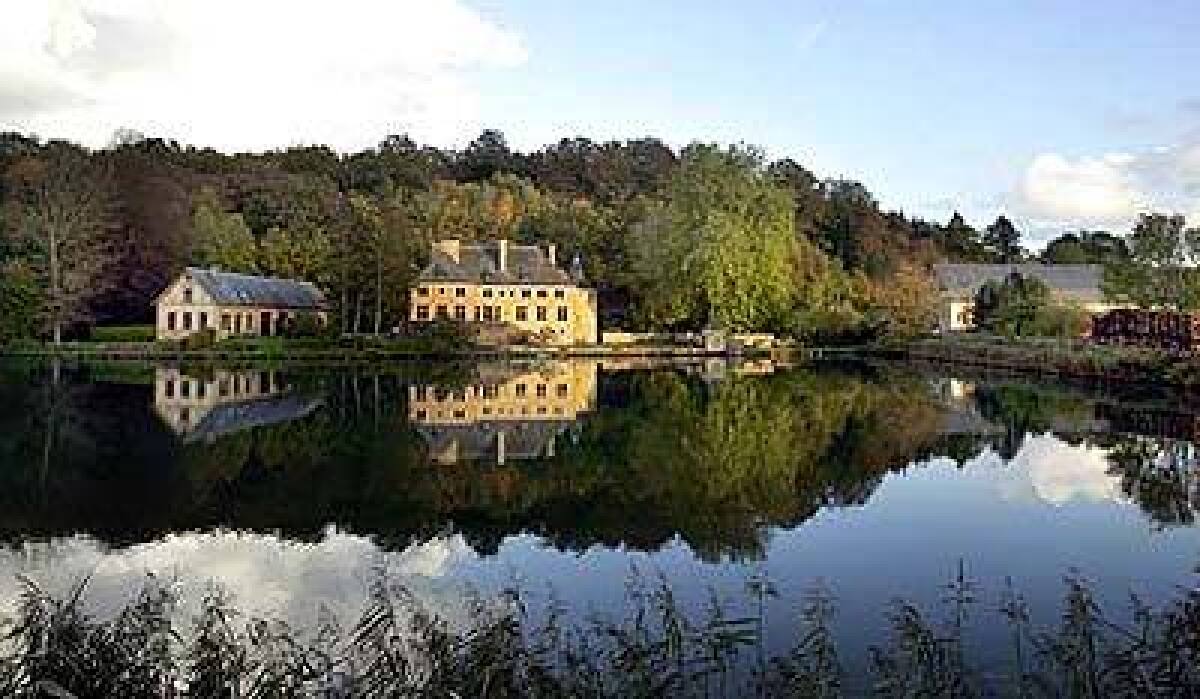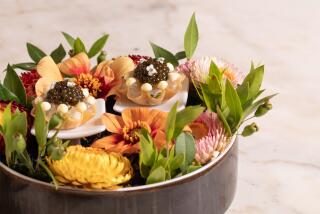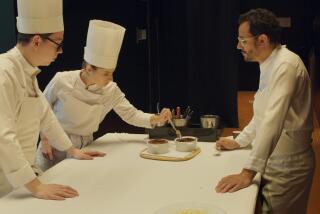Belgium’s gentle fall

I could never fathom why people return to the same place over and over. There’s so much of the world to see. But I’m now beginning to understand how a place can grow on you, having been twice to the Ardennes.
I first visited this lovely, low-key corner of western Europe in August in stultifying heat and electrical storms to celebrate my 50th birthday. I passed that milestone with surprising contentment at a fine, old country inn. Then I went back to see the way autumn sneaks into the Ardennes, turning old oak and beech forests yellow, laying morning mists over the Semois River and filling the markets with squash in surprising shapes and colors.
The Ardennes is an amorphous region of southeastern Belgium, Luxembourg and France. The name — which comes from the Gaulish word arduenna, goddess of hunting — denotes a forest and weathered massifs lined by rocky cliffs. I doubt many Americans could pinpoint it on a map.
The confusion is understandable because the Ardennes is in the geographically confusing, culturally blended heart of the Continent. The region, contested in the 1944 Battle of the Bulge, was a German portal to the west in both World Wars. Its language and wines are French; its taste for robust meat and potatoes German; its modest, gray stone villages with bulb-shaped church steeples quintessentially Belgian.
The region is cleaved by the Semois River, which flows through Belgium and France before emptying into the Meuse. Along the way, it twists and turns through the forests and meadows like a loose spring, inviting walkers and cyclists, kayakers and canoeists. Country lanes, rarely posted with signs, meander back and forth across the river, making it fun to explore by car but hard to figure out where you are from one bend to the next.
On my first visit, I drove a rental car from Paris, where I live, to the Ardennes, a three-hour trip. I got lost almost as soon as I turned off the main highway in Charleville-Mézières, a city on the French-Belgian border, and headed north in search of little D31, which follows the French stretch of the Semois River (known there as the Semoy) as it slices deep valleys into the Ardennes.
Belgium around the bend
Once I found the road and river, I stopped for lunch at Café de Blossette, in Tournavaux, where there was just one thing on the menu: delicious, homemade meat pie. When I told the men smoking unfiltered cigarettes and drinking coffee at a table nearby that I was headed across the border, one of them shook his head sadly and said, “Don’t bother. The scenery is better in France.”The river makes no such distinctions as it wanders into Belgium near the hamlet of Rochehaut. The road, which has been traveling through a mixed hardwood forest, rounds a curve, bringing into view the fairy-tale village of Frahan far below. It sits prettily inside a full loop of the Semois at a spot that, but for its palette, recalls the goosenecks of the San Juan River in southeastern Utah.
Bouillon, the biggest town in the area, is a 30-minute drive east. Its 5,500 inhabitants live, feudal style, in tidy cottages and row houses around the base of a razorback ridge, hemmed in by the river on three sides. On top is a seemingly impregnable castle.
Built in the 8th century, Bouillon Castle was the seat of the House of Ardenne until 1096, when the fifth duke, stalwart Godfrey of Bouillon, sold it to finance an army of Crusaders headed for Palestine. They conquered Jerusalem in a bloodbath, earning Godfrey the title of Defender of the Holy Sepulcher (and, later, his name on the label of a Belgian beer).
It would be hard to imagine a more postcard-perfect medieval castle than Godfrey’s, with slit windows for archers, dank dungeons, thick walls and three gates hewn out of solid rock, separated by bridges.
A young man presenting a falconry demonstration in the courtyard sent vultures, falcons and big-eyed owls — seemingly too stout to get off the ground — flying, at his command, to perches on the castle wall. Then he launched a stuffed rabbit on a skateboard across the courtyard, which was set upon by the carnivorous birds, much to the glee of the kids in the audience.
By this time, I was more than ready to get to Auberge du Moulin Hideux, near Bouillon, one of the first country inns outside France to be accepted into the vaunted Relais & Châteaux chain. It is expensive ($265 to $335 a night for a double, $70 to $95 per per- son for the set-price dinner, without wine) but not nearly as dear as other Relais & Châteaux hotels I’d priced in the nearby French Champagne country. I was ready to splurge for ironed sheets and foie gras to grease my 50th going down.
The auberge occupies a restored 18th century millhouse, so deeply tucked into its valley that my cellphone didn’t work. It has a pond with swans and geese, a small indoor swimming pool, trailheads leading into the forest, a delightful second-floor sitting room, tasteful chambers and the air of a country house party.
Dinner was wonderful, a long, lush ritual that started with a flute of champagne and chevre-cheese-wrapped green grapes under an umbrella table on the front lawn. Then I was ushered to my table in the dining room to study the menu and order, advised by both the sommelier and waiter. I had tuna carpaccio with green tomatoes, codfish in a sauce of North Sea mussels and baby shrimp, a little ball of blackberry sorbet to cleanse the palate between courses, pheasant in cherry sauce, selections from the cheese table and chocolate mousse cake, all accompanied by a white Chassagne Montrachet 2000.
Understandably, I slept in the morning after the celebration. But I spent the afternoon sightseeing along country roads that led to the ruined 12th century castle at Herbeumont and to the thriving market town of Florenville. There I bought a hiking map (for future reference) and a pâté Gaumois for a picnic lunch at Jean-Claude Romain Boucherie-Charcuterie, just off the square, expecting the same sort of meat pie I’d enjoyed at the Café Blossette on the French side of the Ardennes. But this one was fundamentally Belgian, filled with dense, spicy pork, underscoring the subtle differences even in recipes across tight European borders.
Florenville’s 19th century Our Lady of the Assumption church was bombed in World War II and rebuilt in 1951. I climbed to the top of the 150-foot tower to see the snaking Semois and the forests that surround it. Coming back down the spiral staircase, I froze, clutching the banister, as the church bells commenced to boom in a scene right out of Alfred Hitchcock’s “Vertigo.”
Frosty mug at the Abbey
From there, it was a pretty, 30-minute drive to the 11th century Abbey of Orval, near the town of Villers-Devant-Orval. Its proximity to France posed recurrent problems, especially after the French Revolution, when the abbey was destroyed by Republican armies and abandoned. It lay empty and idle until the early 20th century, when French Cistercian monks brought it back to life.
The order believes that putting down roots and working hard are good ways to God, which explains Orval’s greatest claims to fame: its dark, slightly bitter beer, from a Trappist recipe, and smooth, soft cheese, patterned on French Port-du-Salut. You can buy both at the abbey’s gift shop and sample them at the nearby Guardian Angel Inn, where I had an Orval cheese croque-monsieur sandwich and beer.
At home in Paris afterward, I kept thinking about pâté Gaumois, Godfrey of Bouillon and how the Ardennes would look in the fall. So I returned in early October during a quiet midweek to see the leaves and go walking in the woods with my sister, Martha, who lives in Brussels, about an hour and a half by car.
I didn’t get lost as I retraced the roads to eastern Belgium but wondered what I was doing, going back to a place I’d already seen, when the greater Alps and Pyrenees beckoned. The Ardennes is comparatively modest and mild, with only a handful of tourist sights.
Fall is subtler in the Ardennes, I discovered, all muted orange and gold against a pine-green background, with no leaf-peeping tourists expected, foliage reports, bonfires or carved pumpkins. Its joys are best harvested by taking the transformations of nature as they come, even if you don’t happen to be here at the golden peak of the season (late October, I was later told).
This time, Martha and I stayed at the Hostellerie Aux Comtes de Chiny, near Florenville. The three-story stucco inn isn’t as luxurious as the Auberge du Moulin Hideux — nor does it have the distinguished cuisine — but is perfectly comfortable and a fraction of the price. (Our double cost about $61 per person, with breakfast and dinner.)
Gliding on the Semois
I arrived at the hotel first, checked in and walked up the road to see about exploring the river by kayak. The man in the rental office near the landing said it would take about an hour to float down the Semois from Chiny to Lacuisine, where he’d pick me up in a truck. So I clambered into a bright yellow plastic kayak and set off, hoping I wouldn’t encounter any Class IV rapids.As it turns out, the Semois is about as savage as the Easter bunny. Once, a vicious-looking Belgian watchdog barked at me from the bank, and raindrops occasionally splattered from an overcast sky. A heron swooped over the river and two fishermen wished me bon journée. In my kayak, I felt like a yellow leaf drifting along with the current.
That afternoon, Martha and I went for a seven-mile walk in the beech woods to the hamlet of Grandchamps, little more than a dirt crossroads bounded by a farmhouse and barn. We emerged below Chiny at St. Nicholas Bridge, built of dark stone with Roman-style arches, then followed the river back to the inn.
Later, dinner at the hotel featured delicious, pink, pillowy trout from the Semois and a bottle of white French Sancerre wine. We sat there for a long time, talking, as sisters do, about life’s passages. This second visit to the Ardennes had made me realize they rarely come all at once, at a milestone, but evolve gradually like the changing of the seasons, impossible to retard. One can only accept them as gracefully as possible, which didn’t seem hard to do as darkness settled over the Ardennes woods and Semois River.
*
(BEGIN TEXT OF INFOBOX)
Continent’s heart
GETTING THERE:
From LAX to Paris, nonstop service is available on Air Tahiti Nui and Air France; connecting service (change of plane) is available on United, British, Northwest, American, Continental, Lufthansa, Delta, US Airways, Air Canada and Aer Lingus. Restricted round-trip fares begin at $518.
From LAX to Brussels, connecting service is available on American, United, KLM, Delta, British, Continental and Aer Lingus. Restricted round-trip fares begin at $521.
TELEPHONES:
To call the numbers below from the U.S., dial 011 (the international dial code), 32 (the country code for Belgium) and the local number.
WHERE TO STAY:
Auberge du Moulin Hideux, Rue du Moulin Hideux, B-6831 Noirefontaine; 61-46-70-15, https://www.moulinhideux.be . Classic French-Belgian country inn is in an 18th century millhouse, with polished service and haute cuisine. Doubles $265-$335, including breakfast.
Aux Comtes de Chiny, Embarcadère 35, B-6810, Chiny-sur-Semois; 61-32-05-44, https://www.comtesdechiny.be . Doubles with private baths $122, including breakfast and dinner.
Le Prieuré de Conques, Rue de Conques, 2, B-6820, Florenville; 61-41-14-17, https://www.conques.be White-washed priory dating to the 12th century has 18 rooms. Doubles $130 to $190, including breakfast.
WHERE TO EAT:
The best area restaurants are attached to hotels, listed above. Others include:
Auberge de L’Ange Gardien, B-6823 Villers-devant-Orval; 61-31-18-86, https://www.orval.be/fr/accueil/accueil.html . This is a prime spot for dishes made with abbey cheese.
Jean-Claude Romain, Place des Chasseurs Ardennais, Florenville; 61-31-11-12, is a good place for picnic supplies.
TO LEARN MORE:
Belgian Tourist Office, 780 3rd Ave., Suite 1501, New York, NY 10017; (212) 758-8130, https://www.visitbelgium.com .
Florenville Tourist Office, Place Albert I, 61-31-12-29, https://www.semoistourisme.be .
— Susan Spano
More to Read
Sign up for The Wild
We’ll help you find the best places to hike, bike and run, as well as the perfect silent spots for meditation and yoga.
You may occasionally receive promotional content from the Los Angeles Times.






